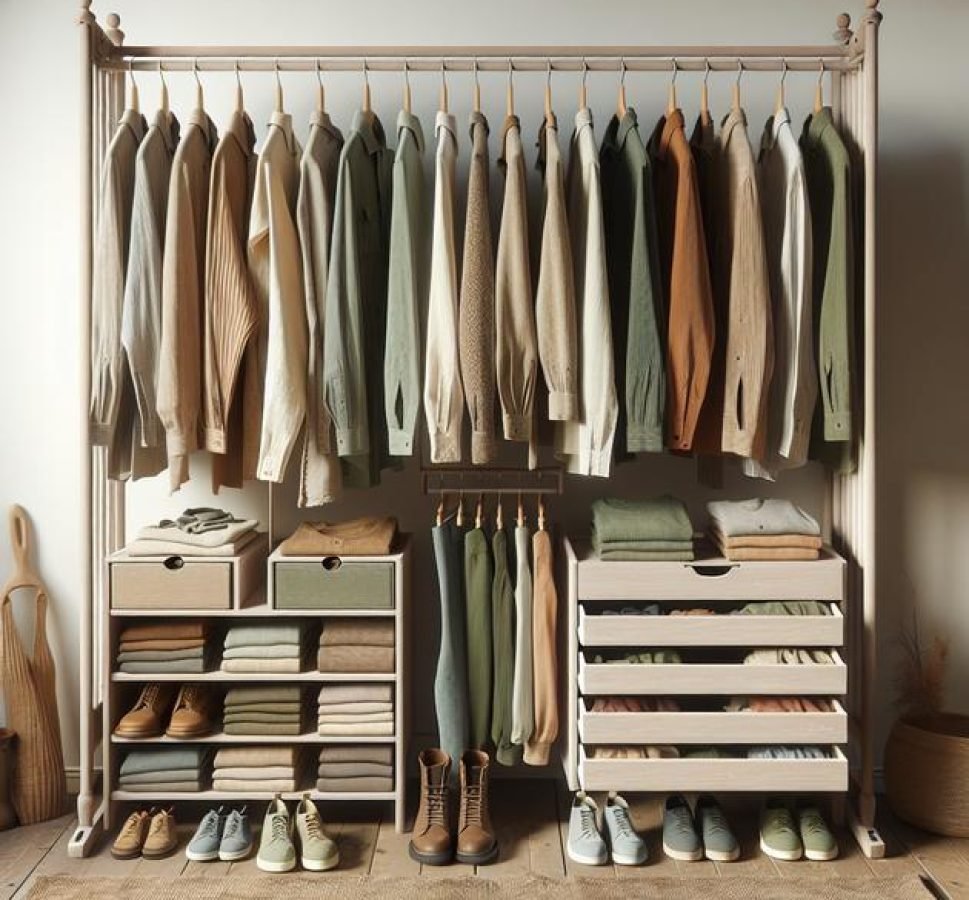Sustainable fashion tips involve choosing eco-friendly fabrics, supporting ethical brands, caring for clothes to extend their life, thrifting, minimizing waste through recycling and upcycling, and building a versatile minimalist wardrobe.
Looking for ways to make your wardrobe more eco-friendly? Sustainable fashion tips can help you rethink buying habits and care routines. Ever wondered how small choices in clothing impact the planet and your lifestyle?
understanding sustainable fashion: what it means and why it matters
Sustainable fashion focuses on creating clothing in ways that are environmentally friendly and socially responsible. It aims to reduce the negative impact of the fashion industry on the planet and the people involved in making clothes. This means using resources wisely, reducing waste, and ensuring fair treatment for workers.
Why is sustainable fashion important? The traditional fashion industry is one of the largest polluters worldwide, contributing to water waste, excessive energy use, and harmful chemicals. Choosing sustainable fashion helps protect natural resources and supports ethical labor practices.
Core principles of sustainable fashion
- Environmental care: Using organic or recycled materials and eco-friendly dyes.
- Ethical production: Fair wages and safe working conditions for workers.
- Durability: Creating high-quality garments to last longer and reduce waste.
- Reducing waste: Minimizing fabric scraps and encouraging recycling or upcycling.
By understanding these basics, consumers can make informed choices that support a healthier planet and a fairer fashion industry. Small actions, like buying fewer but better clothes or supporting brands committed to sustainability, make a big difference.
how to choose eco-friendly fabrics and materials
Choosing the right fabrics is key to sustainable fashion. Eco-friendly materials are made with less harm to the environment and often use fewer chemicals and water in production. Some popular options include organic cotton, hemp, linen, and bamboo. These fabrics grow without harmful pesticides and require less water, making them a greener choice.
Natural vs. synthetic fibers
Natural fibers such as cotton, wool, and silk are biodegradable and often better for the environment. However, not all natural fibers are sustainable if grown with pesticides or intensive water use. Synthetic fibers like polyester and nylon are made from petroleum and can take hundreds of years to break down. Choosing recycled versions of these synthetics can reduce waste.
Look for certifications
Certifications such as GOTS (Global Organic Textile Standard) and OEKO-TEX help identify eco-friendly textiles. These labels ensure fabrics meet strict environmental and social standards during all stages of production.
Recycled fabrics are another good option. They reduce waste by repurposing materials like plastic bottles or fabric scraps into new yarns. This saves resources and lowers landfill waste.
When shopping, consider fabric durability too. Sustainable fashion means buying clothes that last longer and reduce the need to replace frequently. Choosing breathable, comfortable, and sturdy materials supports this goal while keeping you stylish and comfortable.
thrifting and secondhand shopping: benefits and tips

Thrifting and secondhand shopping are great ways to embrace sustainable fashion. Buying pre-loved clothes reduces waste and cuts demand for new production, which saves resources and lowers pollution.
Benefits of thrifting
- Environmental impact: Keeps garments out of landfills and reduces the carbon footprint from manufacturing and shipping.
- Unique style: Find one-of-a-kind pieces that stand out and reflect your personality.
- Cost-effective: Save money by purchasing quality clothes at a fraction of the original price.
Tips for successful thrifting
- Visit local thrift stores regularly to discover the best finds.
- Check for signs of wear or damage; sometimes clothes just need minor repairs.
- Try everything on to ensure proper fit, as sizing can vary widely.
- Look for classic, timeless pieces that can be styled in multiple ways.
- Don’t hesitate to upcycle or customize items to fit your style.
By choosing secondhand, you support a circular economy where clothes have longer lives. This approach not only saves money but also aligns with ethical and environmental values.
caring for your clothes to extend their life
Proper care for your clothes is essential to extend their life and reduce fashion waste. Simple habits can keep garments looking fresh and lasting longer.
Washing tips
- Use cold water to wash clothes; it uses less energy and prevents fabric damage.
- Turn clothes inside out to protect colors and prints.
- Choose gentle cycles for delicate fabrics.
- Avoid overloading the washing machine to reduce friction and wear.
Drying advice
- Air-dry clothes when possible to prevent shrinkage and fabric stress.
- If using a dryer, select low heat settings.
- Hang garments properly to keep their shape.
Storage and maintenance
- Fold sweaters and knits instead of hanging to avoid stretching.
- Use padded hangers for delicate items to maintain shape.
- Fix small tears or loose buttons immediately to prevent further damage.
Regularly caring for your wardrobe not only saves money but also supports sustainable fashion by reducing the demand for new clothes. These simple steps make a big difference in preserving your favorite pieces.
supporting ethical brands and fair trade
Supporting ethical brands means choosing companies committed to fair labor practices and environmental responsibility. These brands prioritize safe working conditions, fair wages, and respect for human rights throughout their supply chains.
What is fair trade?
Fair trade certification ensures that producers, often in developing countries, receive a fair price for their work and products. It also promotes sustainable farming and production methods to protect the environment.
How to identify ethical brands
- Look for certifications like Fair Trade Certified, SA8000, or B Corp.
- Research brand transparency about their factories and sourcing.
- Support local or small businesses that follow ethical standards.
Choosing ethical brands helps reduce exploitation and environmental damage in the fashion industry. With every purchase, you can support workers’ rights and sustainable practices, making your wardrobe a force for good.
minimizing waste: recycling and upcycling garments

Minimizing waste is a crucial part of sustainable fashion. Recycling and upcycling garments help reduce the amount of clothing that ends up in landfills and lowers the need for new materials.
Recycling textiles
Textile recycling involves turning old or damaged clothes into new fibers or products. This can include shredding fabrics to create insulation or stuffing, or reprocessing fibers into new yarns.
Upcycling ideas
- Transform old t-shirts into tote bags or cleaning rags.
- Add patches or embroidery to refresh worn garments.
- Cut and sew pieces from damaged clothes to create new styles or accessories.
DIY upcycling not only extends the life of garments but also sparks creativity and personal style. Many brands now offer services to repair or customize clothes, promoting a more circular fashion economy.
By choosing to recycle or upcycle, you actively reduce waste and contribute to a greener planet.
building a minimalist wardrobe with versatile pieces
Building a minimalist wardrobe means choosing versatile pieces that can be mixed and matched easily. This approach helps reduce overconsumption and supports sustainable fashion by focusing on quality over quantity.
What to include
- Neutral-colored basics like black, white, gray, and navy for easy coordination.
- Classic items such as a well-fitted blazer, plain t-shirts, denim jeans, and a little black dress.
- Multi-purpose accessories that complement many outfits, like scarves and simple jewelry.
Benefits of a minimalist wardrobe
- Less clutter and more space in your closet.
- More thoughtful purchasing habits that save money over time.
- Reduced decision fatigue, making daily outfit choices easier.
Investing in durable and timeless pieces means your clothes last longer and stay stylish. This not only benefits your wallet but also the environment by cutting down on fashion waste.
how to spot greenwashing in fashion marketing
Greenwashing is when brands use misleading claims to appear more sustainable than they actually are. It’s important to know how to spot these tactics to make informed choices.
Common greenwashing signs
- Vague terms like “eco-friendly” or “green” without proof or certification.
- Lack of transparency about materials, production processes, or supply chains.
- Overemphasis on one sustainable aspect while ignoring other harmful practices.
- Use of images or symbols like leaves, earth, or recycling icons without backing them up.
How to verify a brand’s claims
- Look for recognized certifications such as GOTS, Fair Trade, or OEKO-TEX.
- Check if the brand publishes detailed sustainability reports.
- Research third-party reviews or watchdog organizations.
- Be cautious of limited edition “green” collections that don’t align with the brand’s overall practices.
Being careful and asking questions helps avoid supporting brands that only pretend to be sustainable. Genuine transparency and accountability are key.
Key takeaways on avoiding greenwashing
Being aware of greenwashing helps you make smarter, more responsible fashion choices. Always look for clear proof of sustainable practices instead of trusting vague claims.
Checking certifications and researching brands can save you from supporting misleading marketing. True sustainability means transparency and real effort to reduce impact.
By staying informed, you contribute to a cleaner, fairer fashion industry that benefits both people and the planet.





